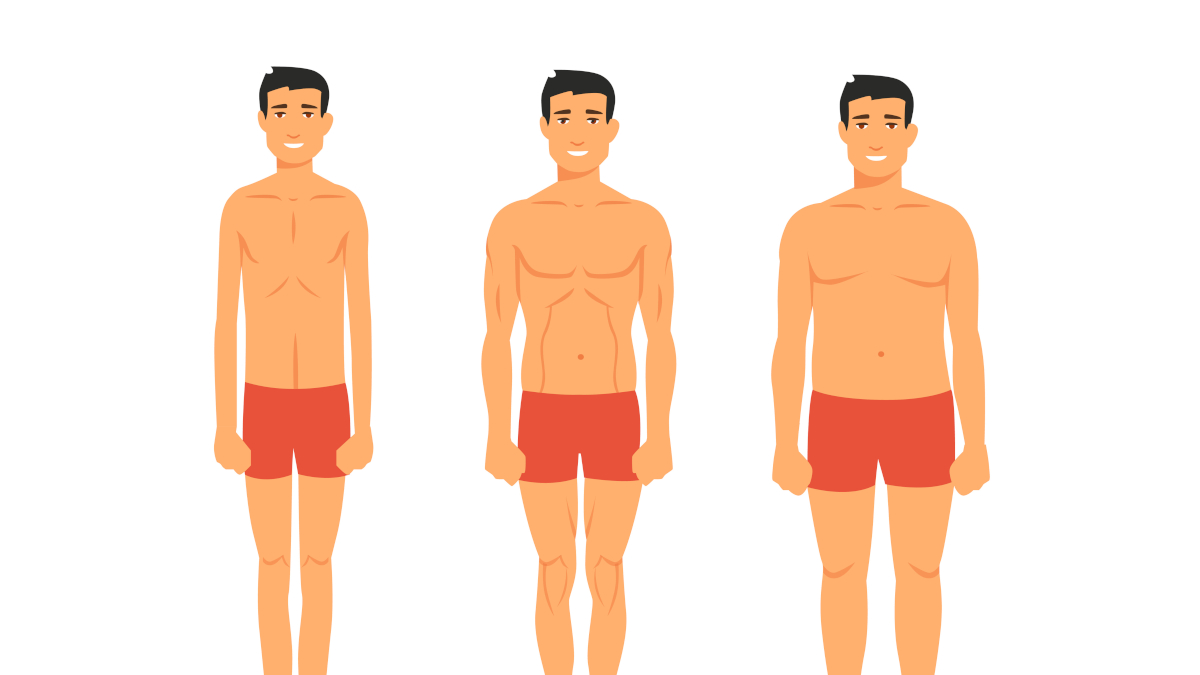
The 3 types of metabolism: which is yours? What can you do to optimise it?
Which is your morphotype and metabolism according to William Sheldon’s characterisation? Discover how to gain, stabilise or lose weight, depending on your particular classification.
Metabolism and morphotypes, according to William Sheldon
The following classification of different metabolism types is directly inspired by the morphotype theory of William Sheldon, an American doctor from the first half of the 20th century whose work has had a significant impact.
He believed that we are all biologically determined before birth, hence the use of terms borrowed from embryology in his classification. Essentially, his theory was that (1):
- ectomorphs are destined to have a more developed nervous and cerebral system (inherited from the embryonic ectoderm) and are therefore thinner, more willowy and fine-boned;
- mesomorphs are predetermined to have a developed muscular and circulatory system (inherited from the mesoderm) and will therefore have a more muscular and toned body;
- endomorphs are destined to have a more developed digestive system (inherited from the endoderm) and are therefore plumper, with softer, less muscly bodies.
But William Sheldon didn’t stop there: he believed these morphotypes or somatotypes to be associated with the following behavioural characteristics:
- ectomorphs would be more nervous, hardy, shy, introverted, sensitive to art, etc.;
- mesomorphs would be braver, more energetic, active, authoritative and dynamic, even aggressive;
- endomorphs would be more tolerant, extroverted, cheerful, seeking luxury and comfort.
This concept has similarities with the Ayurvedic theory of 3 doshas: vata (which would correspond to the ectomorph), pitta (which would correspond to the mesomorph) and kapha (which would correspond to the endomorph), cf. see our blog article on these 3 doshas.
Metabolism: beware of determinism!
William Sheldon’s whole theory has since been rejected. On the one hand, it is now accepted that the behavioural and psychological aspect of his classification is absurd; no-one supports it anymore (2-3).
On the other, recent studies have shown that throughout life, we all exist in reality on a continuum between different morphotypes depending on our muscle mass, fat mass, stress levels, etc. (4)
We therefore need to remember that determinism has no place here and that there are definitely ways of optimising your metabolism, promoting muscle gain or fat loss, stabilising your weight and improving your stress management.
Such methods rely on exercise, diet, meditation, psychological support and selected dietary supplements.
Ectomorph metabolism
According to William Sheldon’s classification, an ectomorph is thin with minimal muscle.
Even though his theory is outdated, it’s undeniable that this description does indeed correspond to reality for many individuals.
However, the problem arises when you have an ectomorph physique and the metabolism that goes with it: however much you try to put on weight or to gain muscle, it simply doesn’t work.
This can mean several things:
- an unsuitable diet: in order to gain weight or muscle, it’s essential to consume surplus calories. This therefore presupposes an already adequate calorie intake. It’s also possible that the digestive system is failing to absorb nutrients properly. In this case, as well as carefully calculating your basal metabolic rate and calorie intake, it can help to take a probiotic formulation such as Probio Forte to support your digestion;
- insufficiently intensive exercise and weight-training sessions: in order to gain muscle mass, you need to generate muscle damage to stimulate anabolism. To promote the body’s production of ATP (the energy used by muscles during exercise), many fitness enthusiasts take branched-chain amino acids (such as the product BCAA’s) and creatine (such as the formulation 3-Creatine, combining three forms of creatine) (5);
- problems with sleep and stress management: sleeplessness and stress cause the body to produce cortisol (known as the ‘stress hormone’), which promotes muscle catabolism. To counter such problems, you can use natural remedies such as Adrenal Support, a synergistic formulation which helps to maintain resistance to stress, and Advanced Sleep Formula, which contains high levels of melatonin and valerian to help you sleep better (6).
Attention: weight-training increases your muscle mass and therefore your metabolism. So you’ll need to boost your calorie intake in order to continue gaining weight and muscle.
Mesomorph metabolism
In William Sheldon’s classification as in real life, those categorised as mesomorphs are the lucky ones. They have a a well-balanced physique and a favourable metabolism which means they can be relaxed about what they eat without putting on weight.
So for mesomorphs, the challenge is primarily to remain stable, and to avoid tipping over into endomorph, or more rarely, ectomorph, territory (the body more naturally tends towards endomorphism).
There are three possible ways of ensuring this:
- take regular, medium-intensity exercise in order to continue stimulating your metabolism and maintaining sufficient muscle mass, particularly to ward off age-related sarcopenia, the natural loss of muscle that comes with ageing (7);
- take care of your immune system and help your body fight oxidative stress in order to stay healthy and maintain equilibrium, using synergistic formulations such as InflaRelief, which contains 12 natural substances (extract of hop, nettle, cat’s claw, tulsi, bromelain, ginger, quercetin, turmeric, rutin, rosemary, 5-Loxin® and Biopérine®);
- some people also choose to counterbalance their potential excess energy with relaxation sessions alongside taking ‘legal cannabis’ (such as the supplement CBD Oil) (8).
Endomorph metabolism
That just leaves the endomorphs, who gain weight easily and lack tone and energy. By definition, there’s a discrepancy between their metabolic rate and their energy intake which means they can quickly tip over into obesity.
Since the 1990s, scientists have been studying the role played by a specific hormone called leptin in the mechanisms governing obesity (9).
In short, when cells contain too much fat, they produce leptin in order to signal to the brain to stop taking in food and storing fat.
While diet is undoubtedly the main cause of obesity, it also seems that eating too much sugar and fat eventually causes leptin receptors to lose their sensitivity. Overcoming obesity then becomes very difficult.
Consequently, the ways in which you can compensate for an endomorph-type metabolism are as follows:
- commit to taking regular exercise (at least two or three times a week) of increasing intensity (start off with light activity, increasing it to moderate and then intensive once your body is used to it so that you don’t damage your joints and tendons). This will have the effect of increasing your metabolism and helping you to build muscle, which in turn further increases your metabolism. In other words, you need to swap the vicious circle for a virtuous one. It’s not easy, but it’s essential;
- change the way you eat. It’s not about ‘going on a diet’ but changing the way you treat yourself. It means gradually giving up sweets, pastries, charcuterie and other unhealthy, high-calorie foods and instead adopting a diet with low glycaemic index (GI) foods, which quickly produce a feeling of satiety and which are full of vitamins and antioxidants. You can then increase your food intake to combat food cravings, as long as these snacks consist of fruit (the whole fruit) and even nuts (but don’t overdo it as they’re high in calories);
- enrich your diet with specific dietary supplements to help improve your metabolism. Synergistic formulations such as Advanced Fat Burner for example (which contains, in particular, Coleus forskohlii, recognised for supporting weight control and fat metabolism), natural remedies such as Gymnema sylvestre (an Ayurvedic plant known for its ability to normalise the metabolism of sugars and to support weight management) and Ginseng 30% (the no. 1 plant in Chinese medicine, which maintains vitality and helps to support the immune system) are all excellent aids for optimising an endomorph-type metabolism (10-11).
References
- SHELDON, William A. Atlas of men, a guide for somatotyping the adult male at all ages.
- MADDAN, Sean, WALKER, Jeffery T., et MILLER, J. Mitchell. Does size really matter?: A reexamination of sheldon's somatotypes and criminal behavior. The Social Science Journal, 2008, vol. 45, no 2, p. 330-344.
- VERTINSKY, Patricia. Embodying normalcy: Anthropometry and the long arm of William H. Sheldon's somatotyping project. Journal of Sport History, 2002, vol. 29, no 1, p. 95-133.
- CARTER, JE Lindsay, CARTER, JE Lindsay, et HEATH, Barbara Honeyman. Somatotyping: development and applications. Cambridge university press, 1990.
- BURKE, Louise M. Branched-chain amino acids (BCAAs) and athletic performance. International SportMed Journal, 2001, vol. 2, no 3, p. 1-7.
- PEETERS, G. M. E. E., VAN SCHOOR, N. M., VAN ROSSUM, E. F. C., et al.The relationship between cortisol, muscle mass and muscle strength in older persons and the role of genetic variations in the glucocorticoid receptor. Clinical endocrinology, 2008, vol. 69, no 4, p. 673-682.
- MORLEY, John E., ARGILES, Josep M., EVANS, William J., et al.Nutritional recommendations for the management of sarcopenia. Journal of the american Medical Directors association, 2010, vol. 11, no 6, p. 391-396.
- WHITE, C. Michael. A review of human studies assessing cannabidiol's (CBD) therapeutic actions and potential. The Journal of Clinical Pharmacology, 2019, vol. 59, no 7, p. 923-934.
- IZQUIERDO, Andrea G., CRUJEIRAS, Ana B., CASANUEVA, Felipe F., et al.Leptin, obesity, and leptin resistance: where are we 25 years later?. Nutrients, 2019, vol. 11, no 11, p. 2704.
- HENDERSON, Shonteh, MAGU, Bahrat, RASMUSSEN, Chris, et al.Effects of coleus forskohlii supplementation on body composition and hematological profiles in mildly overweight women. Journal of the International Society of Sports Nutrition, 2005, vol. 2, no 2, p. 1-9.
- POTHURAJU, Ramesh, SHARMA, Raj Kumar, CHAGALAMARRI, Jayasimha, et al.A systematic review of Gymnema sylvestre in obesity and diabetes management. Journal of the Science of Food and Agriculture, 2014, vol. 94, no 5, p. 834-840.
Keywords
2 Days
Great service
Great service items dispatched straight away and arrived on time
M***** G***
6 Days
A good webshop for supplements
A good webshop for supplements, it has a large selection of them and considering the quality, the pricing offers good value for money. The ordering process is easy and the products are sent straight away.
Maurice
8 Days
Great quality
Products are of great quality and fast delivered.
Fred Laan
9 Days
SuperSmart destaca por la calidad de…
SuperSmart destaca por la calidad de sus productos.
GONZALEZ PALACIN Luis
10 Days
snelle levering,perfect product.
snelle levering,perfect product.
robert
10 Days
Been a customer for over 15 years and…
Been a customer for over 15 years and find their products along with the service excellent. I recommend Super Smart to all my friends.
Del Chandler
11 Days
Excellent product and service
The product was excellent and so were the delivery and the service
F. Ferlitz
13 Days
Never an issue ordering
Never an issue ordering. Simple and to the point. And product always comes the following day. Quality is great too!
Andrea
14 Days
Excellente service & products with rare…
Excellente service & products with rare revelation supplements I love ❤️
Giovanna Escalera
15 Days
Fast shipping
Fast shipping, products as ordered!
Coindozer
15 Days
The item arrived on time and is what…
The item arrived on time and is what was stated in the order.
HARDY Chris
18 Days
Very good products
Very good products. Very reliable. Quick delivery.
MIFSUD Joseph
22 Days
Fast shipping
Fast shipping, good products (just shipping costs to my country are extremely high).
Tanja Matko
23 Days
Many thanks.
Many thanks.
Alan
23 Days
Quick delivery and good product
Quick delivery and good product
cl



